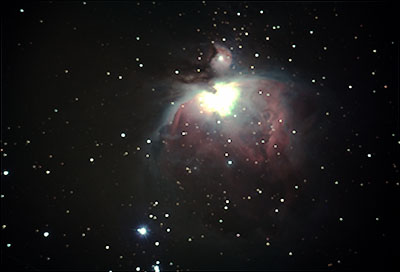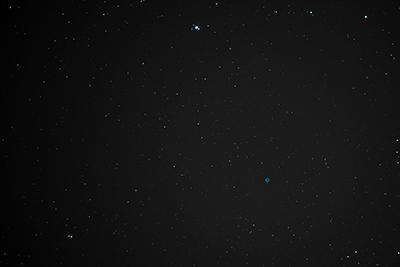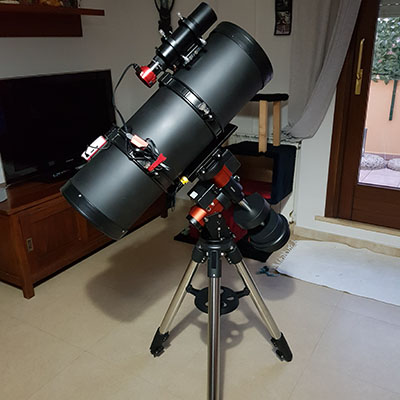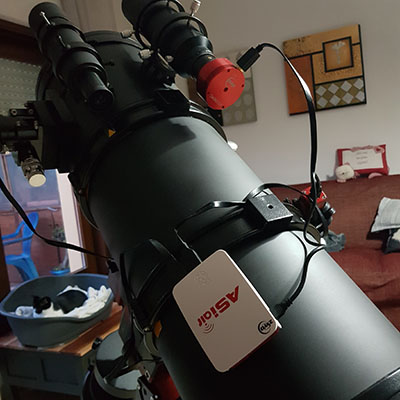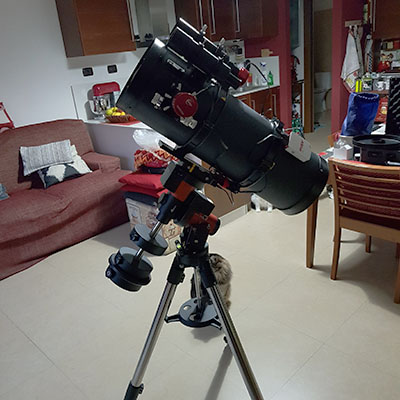The first light
Yes, finally something has moved!! The first light from my setup has arrived:
First of all, I know, there're many issues in this image: it isn't in focus, the stars aren't a point and if you click the thumbnail you'll see the shadow of the secondary mirror in the centre of the stars. Then the core of M42, the Orion nebula, is over-exposed and the post-production is really hasty, but it's my first real astronomy photo. I was forgetting that I haven't take any dark or bias frame, flat frame as well, so I can't complain to myself.
But We start from the beginning. I've always loved astronomy since I was a child. I remember looking the sky at night, out of the window studying some astronomy map to learn the constellations. I was, maybe, twelve years old, but I knew many names of stars and many constellations. But I hadn't got a telescope, so I had to look at the sky only using my eyes, and for me was incredible. After a couple of years, I was able to buy a small telescope, it was more a toy but it works pretty well with its mini-tripod. But during the time I read everything about astronomy. Sometimes I was able to buy a book or a magazine in order to watch the stunning photo of the magazine, or to learn some new aspect of the space: galaxies, nebulas, star clusters, neutron stars, black hole.
At that time I was still living in Milan, so the sky wasn't so good and light pollution didn't permit to see many stars in the sky. But when I went to Sardinia I had more opportunities to admire a more beautiful sky during the night. Here there are some areas where the sky is really dark, and they aren't so far from cities. After some year I bought my first real telescope, a classic item: a 100/1000 Newton telescope, with a small equatorial mount. But it was fantastic. With that telescope I saw for the first time Jupiter with its moons, the rings of Saturn and a lot of galaxies and nebulas, until its mount broke down. Then, after the marriage, I lost a bit of interest in astronomy, and I began with photography and, mostly, nature photography, as you can see in this web site. In the meanwhile I had bought a new telescope, a Meade LXD75 with a Schmidt-Newton 8" (203mm x 812mm):
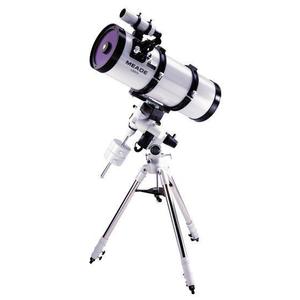
with the Autostar computer, that it's been a huge leap in my astronomy life. The Meade has allowed me to see better many celestial objects, and more easily, due to the Autostar. But the worst issue of the Meade was the mount! During the time the LXD75 had shown some backslash problem, despite my fix it didn't allow me to take a decent photo with my setup, apart some short exposure like this one:
Of course without a camera guide, I knew, it was hard achieving a result as a many photos that I saw on Internet or on some magazines. So I had to change something if I wanted to get some good astrophoto. And now we get to today. I've changed the LXD75 with an iOptron GEM45 mount, that should permit a 22kg's payload, but even give some useful feature like a better cables management when you use a proper camera for taking a photo, or the GPS unit that permits a more precise localization. So now the final setup that I'll use for the future is this one:
And precisely:
- OTA Meade Schmidt-Newton 8" with Moonlite focuser and the original viewfinder 8x50
- Guidescope Technosky 60mm x 240mm used with an ASI 290 camera
- ASI 294MC used as main camera
- ASI Air
- Mount iOptron GEM45 with 17.5 Kg of counterweight
Balancing this setup has been quite tricky because I couldn't find the right position of the OTA, but finally I could. Here some others photo (I'm sorry for the pour quality but I was using my phone).
Of course, I accept any advice of any kind, so if you want to write me about the post-production, or about the setup, or about the stacking-photo, I'm all ears.
Thanks
What do you think?
Send us feedback!

